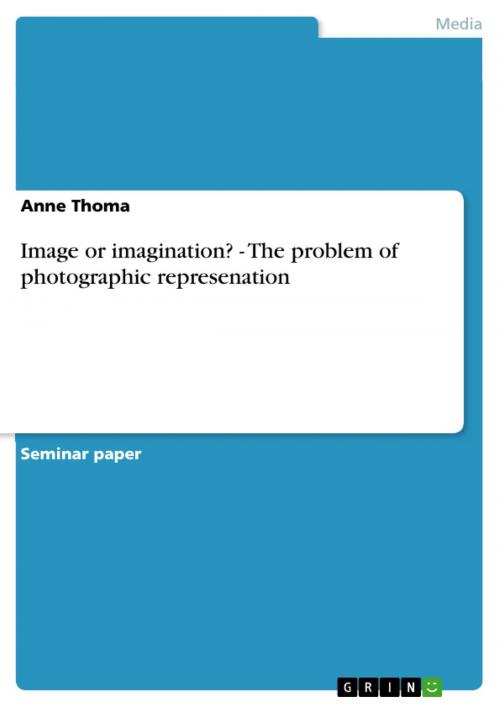Image or imagination? - The problem of photographic represenation
The problem of photographic represenation
Nonfiction, Reference & Language, Language Arts, Journalism| Author: | Anne Thoma | ISBN: | 9783638527040 |
| Publisher: | GRIN Publishing | Publication: | July 27, 2006 |
| Imprint: | GRIN Publishing | Language: | English |
| Author: | Anne Thoma |
| ISBN: | 9783638527040 |
| Publisher: | GRIN Publishing |
| Publication: | July 27, 2006 |
| Imprint: | GRIN Publishing |
| Language: | English |
Seminar paper from the year 2006 in the subject Communications - Theories, Models, Terms and Definitions, grade: 1,0, University of Tubingen (Englisches Seminar), course: Key Terms for Studying Culture, 39 entries in the bibliography, language: English, abstract: Altered pictures have always caused much controversy. Even when photography was still in its infancy, manipulative arrangement was already an issue. Nowadays, digital photography in particular faces an erosion of trust because newsmagazines and newspapers make frequent use of various manipulation techniques, which fiercely challenges the shared belief that photographs record the world objectively and truthfully. Oddly enough, even though a picture may 'lie', it is still used as evidence in the courtroom or understood as a valuable historical document. In my analysis of photography's oscillation between image and imagination, with the two terms representing something traditionally thought of as real on the one hand and something thought of as constructed on the other hand, I want to address these questions and analyse how and what a picture represents. I argue that meaning is to a large extent constructed by the viewer and does not exist as an inherent quality. Consequently, whether an altered picture is seen as fraud or merely as an optimisation is a very subjective matter and strongly depends on contextual information. The viewer's judgement is influenced by the path through which the image is mediated and the context in which it is embedded, but his judgement is also dependent on what the image means to him, not only on what he sees in it. This is not to say that photographs can under no circumstances be used as evidence. However, what can be said is that their truth-value is often overestimated. In any case, manipulation is not a side-effect that coincided with the birth of digital photography. Selection, framing, and other adjustments have always played an important role in film photography. After a general introduction to the basic principles of representation and their development up to the present point of time, I will continue with a brief history of photographic practices and analyse how issues of photographic realism were dealt with in the nineteenth and early twentieth centuries. I will then turn to what is often called 'the myth of photographic truth' and analyse the role of representation in both traditional and digital photography. The last chapter will also broach the role of ideology. In short, I want to argue that photography is capable of meaning, or representing, more than one thing, that it consists of a network of signs and operates both on the basis of predefined structures and personal input.
Seminar paper from the year 2006 in the subject Communications - Theories, Models, Terms and Definitions, grade: 1,0, University of Tubingen (Englisches Seminar), course: Key Terms for Studying Culture, 39 entries in the bibliography, language: English, abstract: Altered pictures have always caused much controversy. Even when photography was still in its infancy, manipulative arrangement was already an issue. Nowadays, digital photography in particular faces an erosion of trust because newsmagazines and newspapers make frequent use of various manipulation techniques, which fiercely challenges the shared belief that photographs record the world objectively and truthfully. Oddly enough, even though a picture may 'lie', it is still used as evidence in the courtroom or understood as a valuable historical document. In my analysis of photography's oscillation between image and imagination, with the two terms representing something traditionally thought of as real on the one hand and something thought of as constructed on the other hand, I want to address these questions and analyse how and what a picture represents. I argue that meaning is to a large extent constructed by the viewer and does not exist as an inherent quality. Consequently, whether an altered picture is seen as fraud or merely as an optimisation is a very subjective matter and strongly depends on contextual information. The viewer's judgement is influenced by the path through which the image is mediated and the context in which it is embedded, but his judgement is also dependent on what the image means to him, not only on what he sees in it. This is not to say that photographs can under no circumstances be used as evidence. However, what can be said is that their truth-value is often overestimated. In any case, manipulation is not a side-effect that coincided with the birth of digital photography. Selection, framing, and other adjustments have always played an important role in film photography. After a general introduction to the basic principles of representation and their development up to the present point of time, I will continue with a brief history of photographic practices and analyse how issues of photographic realism were dealt with in the nineteenth and early twentieth centuries. I will then turn to what is often called 'the myth of photographic truth' and analyse the role of representation in both traditional and digital photography. The last chapter will also broach the role of ideology. In short, I want to argue that photography is capable of meaning, or representing, more than one thing, that it consists of a network of signs and operates both on the basis of predefined structures and personal input.















